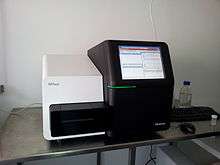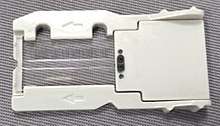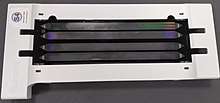Illumina, Inc.
Illumina, Inc. is an American company. Incorporated in April 1998, Illumina develops, manufactures, and markets integrated systems for the analysis of genetic variation and biological function. The company provides a line of products and services that serves the sequencing, genotyping and gene expression, and proteomics markets. Its headquarters are located in San Diego, California.
 | |
| Public | |
| Traded as | NASDAQ: ILMN NASDAQ-100 Component S&P 500 Component |
| ISIN | US4523271090 |
| Industry | Biotechnology |
| Founded | 1998 |
| Founder |
|
| Headquarters | San Diego, California , |
Key people |
|
| Products | NovaSeq 6000, HiSeq X, HiSeq 4000, MiSeq, MiSeqDx, MiniSeq, iSeq 100, NextSeq 550, NextSeq 550Dx, iScan |
| Revenue | |
Number of employees | ~7,300 |
| Website | www |
| Footnotes / references [1] | |
Illumina's technology had purportedly by 2014 reduced the cost of sequencing a human genome to US$1,000, down from a price of $1 million in 2007.[2] Customers include genomic research centers, pharmaceutical companies, academic institutions, clinical research organizations, and biotechnology companies.
History
.jpg)
Illumina was founded in April 1998 by David Walt, Larry Bock, John Stuelpnagel, Anthony Czarnik, and Mark Chee. While working with CW Group, a venture-capital firm, Bock and Stuelpnagel uncovered what would become Illumina's BeadArray technology at Tufts University and negotiated an exclusive license to that technology. In 1999, Illumina acquired Spyder Instruments (founded by Michal Lebl, Richard Houghten, and Jutta Eichler) for their technology of high-throughput synthesis. Illumina completed its initial public offering in July 2000.[3]
Illumina began offering single nucleotide polymorphism (SNP) genotyping services in 2001 and launched its first system, the Illumina BeadLab, in 2002, using GoldenGate Genotyping technology. Illumina currently offers microarray-based products and services for an expanding range of genetic analysis sequencing, including SNP genotyping, gene expression, and protein analysis. Illumina's technologies are used by a broad range of academic, government, pharmaceutical, biotechnology, and other leading institutions around the globe.
On January 26, 2007, the company completed the acquisition of the British company Solexa, Inc. for ~$650M.[4] Solexa was founded in June 1998 by Shankar Balasubramanian and David Klenerman to develop and commercialize genome-sequencing technology invented by the founders at the University of Cambridge. Solexa INC was formed in 2005 when Solexa Ltd reversed into Lynx Therapeutics of Hayward.[5] Illumina also uses the DNA colony sequencing technology, invented in 1997 by Pascal Mayer and Laurent Farinelli [6] and which was acquired by Solexa in 2004 from the company Manteia Predictive Medicine. It is being used to perform a range of analyses, including whole genome resequencing, gene-expression analysis, and small ribonucleic acid (sRNA) analysis.
In June 2009, Illumina announced the launch of their own Personal Full Genome Sequencing Service at a depth of 30X for $48,000 per genome,[7] and a year later dropped the price to $19,500.[8][9] As of May 2011, Illumina reduced the price to $4,000.[10][11]
Until 2010, Illumina sold only instruments that were labeled "for research use only"; in early 2010, Illumina obtained FDA approval for its BeadXpress system to be used in clinical tests.[12][13] This was part of the company's strategy at the time to open its own CLIA lab and begin offering clinical genetic testing itself.[14]
Illumina acquired Epicentre Biotechnologies, based in Madison, Wisconsin, on January 11, 2011.[15] On January 25, 2012, Hoffmann-La Roche made an unsolicited bid to buy Illumina for $44.50 per share or about $5.7 billion.[16][17] Roche tried other tactics, including raising its offer (to $51.00, for about $6.8 billion).[18] Illumina rejected the offer,[2][19] and Roche abandoned the offer in April.[20]
In 2014, the company announced a multimillion-dollar product, HiSeq X Ten, that it forecast would provide large-scale whole-genome sequencing for $1,000/genome.[21][22] The company claimed that 40 such machines would be able to sequence more genomes in one year than had been produced by all other sequencers to date.[23] In January 2014, Illumina already held 70% of the market for genome-sequencing machines.[24] Illumina machines accounted for more than 90% of all DNA data produced.[25] In fact, the amount of data produced by Illumina machines is such that the company invested in the acquisition of the pre-commercial firm Enancio in 2020, which had developed a DNA data compression algorithm specifically targeting Illumina data capable of reducing storage footprint by 80% (e.g. 50 Gb compressed to 10 Gb).[26]
On July 5, 2016, Jay Flatley, who had been CEO since 1999, assumed the role of executive chairman of the board of directors. Francis deSouza took on the role of president and chief executive officer, and continues to serve on the Illumina board of directors.[27][28]
In late 2015, Illumina spun off the company Grail, focused on blood testing for cancer tumors in the bloodstream. In 2017 the company had planned to raise $1 billion in its second round of financing, and received funding from Bill Gates and Jeff Bezos investing $100 million in series A funding, and with Illumina maintaining a 20% holding share in Grail.[29] The company is working with a blood test trial with over 120,000 women during scheduled mammogram visits in the states of Minnesota and Wisconsin, as well as a partnership with the Mayo Clinic. The company Grail uses Illumina sequencing technology for tests.[30] The company plans to roll out the tests by 2019, with a cost of $500 per individual.[31]
In November 2018, the company proposed the acquisition of Pacific Biosciences for $8.00 per share or around $1.2 billion in total.[32][33] The proposed deal was abandoned on January 2, 2020, with Illumina paying Pacific a $98 million termination fee.[34]
Products
DNA sequencing

Illumina sells a number of high-throughput DNA sequencing systems, also known as DNA sequencers, based on technology developed by Solexa. The technology features bridge amplification to generate clusters and reversible terminators for sequence determination.[35][36] The technology behind these sequencing systems involves ligation of fragmented DNA to a chip, followed by primer addition and sequential fluorescent dNTP incorporation and detection.
Three of the most popular Illumina sequencers are the MiSeq, HiSeq, and NovaSeq. From a single run, the MiSeq generates 30 million reads, the HiSeq generates 3 billion reads, and the NovaSeq generates 13 billion reads. Meanwhile traditional Sanger sequencing generates approximately 400 reads. Comparatively, the NovaSeq has the ability to generate 4 trillion bases in a day whereas Sanger sequencing can only generate one million bases per day. New machines have the capacity to sequence the entire human genome in 48 hours at the price of $1,000. Illumina sequencers are highly accurate, and only have an error once every thousand bases.[37]
Flow Cells (MiSeq, HiSeq, and NovaSeq)


Illumina sequencing happens within the flow cells. These flow cells are small in size and are housed in the flow cell compartment. In MiSeq sequencers, the flow cell can generate between 1 million and 30 million reads per run. The HiSeq flow cell is larger than that of the MiSeq and has the ability to generate 3 billion reads per run. Lastly, the NovaSeq flow cell is the largest of the three and can generate 13 billion reads per run. Flow cell clustering happens when a denatured DNA sample is placed in a flow cell. Primers already in the flow cell channel capture and bind to the ends of the short denatured DNA sample. Then, DNA polymerase is added and the DNA building blocks are introduced. This results in a newly synthesized strand constrained to the bottom of the flow cell. Next, the original template strand is washed out binding the newly synthesized strand to the other DNA sequence present on the surface. DNA polymerase and building blocks are introduced again forming a new strand. These steps are repeated until about 1,000 copies are made in a cluster.[37]
Litigation
In 2005, co-founder and former Chief Scientific Officer Anthony Czarnik sued Illumina; see Czarnik v. Illumina Inc.
In 2010, Cornell University and Life Technologies filed a lawsuit against Illumina, alleging that its microarray products infringed on eight patents held by the university and exclusively licensed to the start-up. The case was settled in April 2017 without any finding of fault. In September 2017 both parties asked to have the settlement reviewed, with Cornell accusing both Illumina and Life Technologies of misrepresentation and fraud.[38]
In February 2016, Illumina filed a lawsuit against Oxford Nanopore Technologies, which was the first company to commercialize nanopore sequencing. Illumina claimed that Oxford Nanopore infringed on its patents.[39][40]
In February 2020, Illumina filed a patent infringement suit against BGI relating to its "CoolMPS" sequencing products.[41]
References
- US SEC:Form 10-K Illumina, Inc., U.S. Securities and Exchange Commission, February 12, 2019, retrieved June 20, 2019
- "Illumina's CEO on the Promise of the $1,000 Genome -- And the Work That Remains". Recode. March 25, 2014.
- Stipp, David (3 Apr 2000). "13 Biotech IPOs To Watch For". Fortune. Retrieved 4 Nov 2019.
- Devlin, Hannah (3 April 2020). "Why has the UK lagged behind in testing for the Coronavirus?". The Guardian. Retrieved 21 April 2020.
- "History of Illumina Sequencing". illumina.com. Retrieved 2017-01-25.
- Kawashima, Eric H.; Laurent Farinelli; Pascal Mayer (2005-05-12). "Patent: Method of nucleic acid amplification". Archived from the original on 2013-02-22. Retrieved 2012-12-22{{inconsistent citations}}
- Everygenome.com: Individual genome sequencing - Illumina, Inc. Archived 2011-10-19 at the Wayback Machine
- Kerry Dolan (2010-09-16). "Illumina CEO On The Lunch That Launched Him". Forbes.
- Kevin Davies (2009-06-11). "Illumina To Offer $48,000 Personal Genome Sequencing Service". Bio-IT world.
- "Illumina drops sequencing price to $4,000 - UTSanDiego.com".
- Everygenome.com: Individual genome sequencing - Illumina, Inc. Archived 2011-10-19 at the Wayback Machine
- Petrone, Justin (May 4, 2010). "FDA Clears Illumina's BeadXpress System for Clinical Use". GenomeWeb.
- "510(k) Premarket Notification K093128". FDA. Retrieved 7 April 2017.
- "Big Array Vendors Promise New Chips, Acquisitions, and Diagnostics in 2009". GenomeWeb. January 6, 2009.
- "Illumina .::. Investor Relations News Release". Investor.illumina.com. 2011-01-11. Archived from the original on 2013-11-21. Retrieved 2014-01-18.
- "Roche - Roche offers to acquire all outstanding shares of Illumina, Inc. to further strengthen its leading role in diagnostics". Archived from the original on 2012-02-28. Retrieved 2012-03-07.
- "Xconomy: Five Reasons Illumina Should Fight Roche's Insulting Low-Ball Bid". Xconomy. 5 March 2012.
- Roche and Illumina: Taking it personally. The Economist (2012-04-18). Retrieved on 2013-09-05.
- "Illumina Board Rejects Roche's Hostile Tender". connection.ebscohost.com.
- Roche decides not to extend its tender offer for Illumina, Inc. Archived 2014-08-08 at the Wayback Machine
- Clark, Liat (15 Jan 2014). "Illumina announces landmark $1,000 human genome sequencing". Wired. Retrieved 4 Nov 2019.
- Molteni, Megan (19 Nov 2018). "Now You Can Sequence Your Whole Genome for Just $200". Wired. Retrieved 4 Nov 2019.
- Young, Susan (2014-01-14). "Illumina Claims It's Reached $1,000-Genome Milestone with New High-Throughput Human Genome Sequencer | MIT Technology Review". Technologyreview.com. Retrieved 2014-01-18.
- Zimmerman, Eilene (18 February 2014). "50 Smartest Companies: Illumina". MIT Technology Review. Massachusetts Institute of Technology. Retrieved 25 August 2014.
- Regalado, Antonio. "EmTech: Illumina Says 228,000 Human Genomes Will Be Sequenced This Year". MIT Technology Review. Massachusetts Institute of Technology. Retrieved 26 September 2014.
- Staff (15 July 2020). "Illumina Acquires French Genomic Data-Compression Startup Enancio". GenomeWeb. New York City: Crain Communications. Retrieved 16 July 2020.
- "Jay Flatley to Assume Role of Executive Chairman of the Board of Directors of Illumina; Francis deSouza Appointed President and CEO" (Press release). Illumina. 7 March 2016.
- Staff (July 2016). "People". Genetic Engineering & Biotechnology News (Paper). 36 (13). p. 37.
- Herper, Matthew. "Company Will Raise $1 Billion To Create Blood Test To Detect Cancer". Forbes. Retrieved 2017-04-30.
- "Mayo Clinc scientists on the trail of a 'pan cancer' test". Star Tribune. Retrieved 2017-04-30.
- Swanson, Cheryl (2017-04-30). "Are Jeff Bezos and Bill Gates Wrong About Illumina? -- The Motley Fool". The Motley Fool. Retrieved 2017-04-30.
- "Illumina to Acquire Pacific Biosciences for Approximately $1.2 Billion, Broadening Access to Long-Read Sequencing and Accelerating Scientific Discovery". BioSpace.
- "Illumina Acquires Pacific Biosciences for $1.2 Billion". BioSpace.
- "Illumina abandons $1.2 billion deal to buy rival Pacific Biosciences". CNBC. 2020-01-02. Retrieved 2020-01-03.
- S Balasubramanian RSC Chem. Commun., 47 (26), 7281-7286 (2011)
- Bentley, David R.; et al. (6 November 2008). "Accurate whole human genome sequencing using reversible terminator chemistry". Nature. 456 (7218): 53–59. doi:10.1038/nature07517. PMC 2581791. PMID 18987734.
- "Next Generation Sequencing • iBiology". iBiology. Retrieved 2020-05-15.
- "Cornell revives previously settled patent infringement lawsuit against Illumina".
- "Fight brews over promising genetic-sequencing technology".
- "Illumina sues Oxford Nanopore for patent infringement".
- "Illumina Files Additional Patent Infringement Suit Against BGI in the U.S." BioSpace. Retrieved 2020-02-28.
External links
| Wikimedia Commons has media related to Illumina (company). |
- Illumina's Company Website
- DNAVision - Illumina official service provider.
- Gene Logic - performs research based on Illumina's Golden gate assay
- Illumina's Personal Full Sequencing Genome Service
- National Center for Genome Resources (NCGR) Sequencing Center - an Illumina Certified Service Provider.
- Genotypic Technology GENOMICS SIMPLIFIED - an Illumina Certified Service Provider.
- Map of Illumina NGS Instruments in the United States.
- Business data for Illumina: